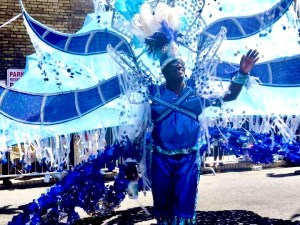It’s Carnival time!!
Carnival on St. Thomas
Ahoy! And welcome aboard!
What’s the most anticipated event of the entire year on St. Thomas? Carnival season, of course, which is a month-long litany of parties, parades and contests that celebrate life and freedom. If you love music, food, dancing and costumes, you won’t be disappointed. Just for fun, random events like toddler races and greased pig contests are part of the mix, too.
The Historical Roots of Carnival
When European immigrants came to the Virgin Islands from countries such as Spain, Portugal, England and Denmark, they brought their celebrations and traditions with them. Street processions, dressy balls, elaborate parties and religious celebrations all became part of island life. Enslaved Africans also brought their traditions of drumming, singing and chanting with them.
While enslaved people were generally not permitted to participate in the European celebrations, they were present as workers and on occasion, as musicians. During holidays like Christmas or New Years, enslaved people were given time to have their own celebrations which over time became a blend of European and African traditions.
Music and dance were always a part of every celebration, though the African traditions of drumming and dance were feared by Europeans. Thought to be a secret way of communication that fostered ideas of rebellion, drumming was banned for a time by plantation owners. So, too, was the dance form known as Bamboula, which originated in West Africa and uses a drum made of goatskin. Using the heels of the hand, drummers alter the timbre, creating powerful rhythmic sounds that vibrate both physically and spiritually.
In August of 1672, Gov. Jorgen Iversen banned bamboula dancing on the island of St. Thomas. Anyone caught dancing bamboula was imprisoned at Fort Christian. Regardless, enslaved people continued the practice and eventually, a decade later, Europeans actually started learning the dance from their servants. Today, the physical and sensuous body movements of Bamboula can be seen at many Carnival celebrations.
The First Carnival on St. Thomas
On January 14, 1912, St. Thomas, part of the Danish West Indies at the time, hosted its first Carnival and in 1914, a second celebration occurred. Celebrations mainly featured bands, a Carnival Queen, special games and a parade – nothing quite as elaborate as today’s celebrations.
After 1914, the tradition stopped for 38 years, not resuming until 1952, thanks to radio personality, Ron De Lugo, who while reminiscing about the tractional celebration, made a plea to resume the festivities. After organizing a Carnival Parade Day, De Lugo was pleasantly surprised to see crowds of people show up for the event, which has continued ever since.
Each of the U.S. Virgin Islands has its own Carnival. On St. Croix, it’s called the Crucian Christmas Festival,which became an annual event in 1952. Reviving old holiday traditions from the early 1800s like parading through the streets of town singing, playing drums, dancing and stopping door to door for wine or rum, this Christmas festival lasts four weeks and culminates with parades in January.
St. John, on the other hand, celebrates Carnival in early July by incorporating two other holidays – Emancipation Day (commemorating the abolition of slavery) and Independence Day (recognizing our nation’s birthday). Originally, St. John’s Carnival ran for a week when it merged with the island’s Fourth of July celebrations in 1960, but today, the revelry lasts several weeks and is called the St. John Festival.
Trending Upwards
Since 1952, Carnival has grown to be the biggest and most anticipated event on St. Thomas. Typically occurring during the month of April, the celebration now features elaborate costumes, masquerade parades, Caribbean music and general revelry that keeps everyone smiling. More than just a giant party, Carnival is also about embracing local culture, unique traditions and the history of the island.
One featured event known as Calypso Tent showcases musical artists who perform for a panel of judges that ultimately declare a winner. This year’s event took place over Easter weekend at the high school auditorium where eight calypso artists had to make up a song on the spot to the theme of: If I Knew Then What I Know Now.
Live music is a mainstay of Carnival, so there are lots of opportunities to dance and party. Calypso and Pan music are traditional Caribbean staples and various competitions showcase the art form which combines musical talent with wit, humor and stage presence. In Calypso the sound of the words is as important as the meaning of the words, and good Calypsonians use their music to make commentaries on social and political events.
But the fun doesn’t end with music. Indulge your senses with firework displays, amusement park rides, and flashy costumes. And bring your children as there are tons of kid-friendly activities.





The final week of Carnival concludes with some of the most popular events, including J’Ouvert, a favorite among locals. When J’Ouvert began, locals congregated at dawn dressed in their nightclothes to dance to the music supplied by roving bands.
But the dress code has changed a bit since then and attire now includes everything from pajama pants and nightshirts to both whimsical and outrageous outfits, perfect for divas wanting to make a fashion statement.
A typical J’Ouvert outfit might include denim shorts over fishnet stockings with fluorescent sneakers or see-through fabrics over wild-colored thongs and crop tops with boots. Those who like to push the limits might opt for body stockings with thongs. Age and size are non-factors for participation so head to Veteran’s Drive prepared to be amused and surprised at participants’ originality.
This Year’s Final Lineup of Events:
April 21 at 6:00 p.m. – Junior Caypso Show at Crown Bay Center
April 22 at 8:00 p.m. – Calypso Monarch (crowning of best calypsonian) at Crown Bay
April 23 at 11:00 a.m. – Boat & Car Show at Waterfront
April 23 at 4:00 p.m. – Panorama at St. Thomas Village
April 24 (Monday 6:00 p.m.) to April 29 (11:59 p.m.) – Opening of Kelly “PUPA KELLY” / Charleswell Musical Arena in St. Thomas Village
April 25 at 6:00 p.m. – Steel Pan & Teen Tramp on Main Street
April 26 at 10:00 a.m. – Food Fair at Emancipation Garden
April 26 at 6:00 p.m. – Quelbe Tramp on Main Street
April 27 at 6:00 a.m. – J’ouvert
April 28 at 12:00 p.m. – Children’s Parade on Main Street
April 29 at 10:00 a.m. – Adult’s Parade on Main Street
April 29 at 9:00 p.m. – Fireworks at St. Thomas Harbor
*There’s so much to see and do, so don’t miss out on the fun!
End Notes: If you enjoyed this post, please share it with your friends. Then visit our website and book a boat day with Stormy Pirates Charters – we’ll put the gang plank down and escort you in style.
